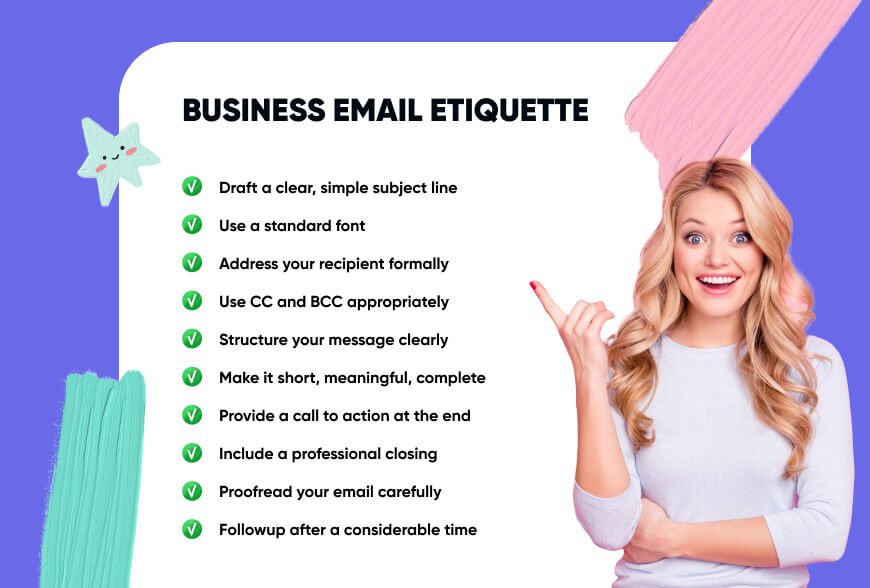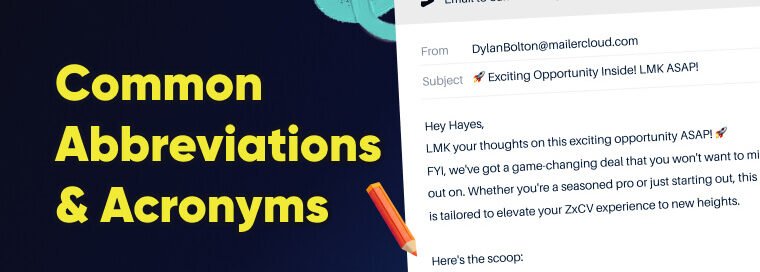E-mail has become the cornerstone of modern business communications. The rise in digital correspondence has made the use of abbreviations common and appealingly designed to make writing both efficient and clear. However, just as much as abbreviations may streamline communication, improper usage might lead to misunderstandings and unprofessional results. This detailed guide will delve deep into the nitty-gritty of using abbreviations in concerning in business emails abbr, their advantages, some of their potential downsides, and the best ways to apply them.
Key Takeaways from the Article
- Business email abbreviations streamline communication, enhancing efficiency and clarity.
- Common abbreviations like FYI (For Your Information), ASAP (As Soon As Possible), and TBD (To Be Decided) are crucial for saving time.
- Proper usage of abbreviations helps build professionalism and can foster trust among business colleagues.
- Misuse or overuse of abbreviations can lead to confusion and communication breakdowns.
- Knowing when and where to use abbreviations ensures that your business emails are concise yet informative.
Introduction
E-mails are among the primary forms of communication in today’s fast-moving business world. With the need for speed and efficiency, abbreviations have become common practice. Such shorthand notation helps to convey a message quickly and clearly. Learning concerning in business emails abbr when and how to use these abbreviations correctly is key to professionalism and equally important to avoiding miscommunication. This guide will explain the most commonly used business email abbreviations in detail and will also focus on their proper usage and other strategies for effective communication.

Business Email Abbreviations: What Are They?
Business email abbreviations are shortened forms or initials that indicate commonly used phrases within professional correspondence. They enhance quick messaging by saving time and reducing the length of the emails. It is helpful to employ these abbreviations in a high-volume email environment where clarity and brevity are key.
Types of Business Email Abbreviations
- Standard Abbreviations: These are recognized and utilized throughout many industries. Examples include:
- FYI-for your information
ASAP – As Soon As Possible
TBD – To Be Decided - Abbreviations applied to particular fields: These abbreviations are meant for certain fields or sectors only. Examples include:
- ROI – Return on Investment in finance
KPI – Key Performance Indicator in management - Company-specific abbreviations: These are abbreviations created locally within an organization for use within the organization. Examples include:
- R&D – Research and Development for project teams
BDR – Business Development Representative in sales
Advantages of Using Abbreviations

Efficiency and Speed
In this world of pace, abbreviations most certainly afford speedier communication. According to the 2022 Statista report, the average number of emails a professional receives is 121 per day. This number, efficiently managed by abbreviations, allows more information to be conveyed in compressed form.
Clarity
Abbreviations make things clearer by reducing message lengths. For example, ETA, or Estimated Time of Arrival, well conveys the needed times without having to be too explanatory.
Professionalism
Appropriately used abbreviations create a sense of professionalism and familiarity with concerning in business emails abbr, indicating that the sender respects and values the receiver’s time.
Common Abbreviations in Business Emails
Following is a detailed list of commonly used abbreviations in business emails:
| Abbreviation | Meaning | Usage |
|---|---|---|
| FYI | For Your Information | To share information without requiring a response |
| ASAP | As Soon As Possible | For urgent tasks or requests |
| TBD | To Be Decided | When details are pending |
| ETA | Estimated Time of Arrival | To provide expected times |
| FWD | Forwarded | To indicate that an email is being forwarded |
| CC | Carbon Copy | To copy someone on an email |
| BCC | Blind Carbon Copy | To copy someone discreetly |
| EOD | End of Day | To specify a deadline by the end of the day |
| NRN | No Response Needed | To indicate no reply is necessary |
| IMO | In My Opinion | To provide a personal viewpoint |
Detailed Analysis of Common Abbreviations

FYI – For Your Information
Purpose: Availed when the sender wants to provide some information to the recipient that does not require any response. Example: “FYI, the meeting has been rescheduled to 3 PM.
ASAP-As Soon As Possible
Purpose: Indicates urgency to finish something or give a reply to it. For example, “Please review the attached document and provide feedback ASAP.”
TBD-To Be Decided
Purpose: Applied when certain details are not yet established. Example: “The date for the next team meeting is yet TBD.”
How Proper Abbreviation Use Improves Communication
Speeds Up Communication
They help simplify communication by avoiding many time-wasting explanations. In such an environment, this speed is considered vital for making quick decisions.
Building Professionalism
When abbreviations are correctly used in business communications, it show professionalism. It thereby shows regard for the recipient’s time and mastery of business language.
Avoiding Miscommunication
Abbreviations lessen misunderstanding since clear and specific information is conveyed when properly applied. But if applied incorrectly, it becomes nonsense to a recipient who may not be aware of the meaning of the abbreviation.
Possible Errors with Abbreviations

Overapplication and Lack of Clarity
Overapplication may result in an email that is at best barely readable. This will surely cause confusion and further lack of clarity regarding the message.
Ambiguity
Some of them have multiple meanings, and misinterpretation may likely occur. A good example is that ETA can mean different things depending on the context in which the abbreviation is used.
Unprofessional Perception
Using abbreviations too much in e-mails or making use of the wrong abbreviations altogether causes these messages to sound informal or unprofessional. One needs to find the balance between being brief and formal.
Best Ways of Using Abbreviations in Business Emails

Know Your Audience
Use abbreviations consistent with how your audience sees them: internally or to well-known contacts, they are usually appropriate. In other situations, communications or less well-known contacts, for instance, is better to use them rarely.
Use Abbreviations Judiciously
Abbreviations must assist in making things clearer-not obscure them. Do not overload your email with abbreviations. They are to be used only when they tend to create a clear benefit with one in which ambiguity is unlikely.
Define Abbreviation When Necessary
If there are any rare abbreviations, explain those at least once so that all recipients will know the message.
Be Brief without Being Unprofessional
Let brevity not in any way demean your being professional. Always make sure to balance both aspects.
Abbreviations Specific to the Industry and Its Impact

Finance
In finance, some examples could be ROI, which stands for Return on Investment, and P&L, which means Profit and Loss. Abbreviations quickly explain the complex terms of finance.
Technology
In this field, some examples of abbreviations would be API, which means Application Programming Interface, and IT, which means Information Technology. It simplifies the communication of technical ideas.
Marketing
In marketing, some examples of common abbreviations could be KPI, which means Key Performance Indicator, and CRM, which is Customer Relationship Management. They use abbreviations to talk about strategies and measures effectively.
Abbreviations in a Virtual Workplace
The use of abbreviations is thus more important since working remotely has become highly popular. Abbreviation thus plays a very important role in a virtual workplace by:

- Allowing for Speedy Communication: When the various team members are operating in different time zones, it is the abbreviations that could help hasten communication.
- Providing Professionalism: They help maintain a professional tone in the emails, hence ensuring that the messages stay clear and concise.
- Abbreviations reduce email overload: First, they help manage the volume of emails; therefore, handling a large amount of communication in a short time becomes conceivable.
According to a survey carried out by Buffer in 2023, 97% of remote workers use email as their main channel of communication, and thus it is important to have good and clear practices in place in this area.
Conclusion
Business abbreviations are thus a tool that can be very helpful to increase efficiency and professionalism in concerning in business emails abbr. Appropriately used, they save time, improve clarity, and reflect a high degree of professionalism. Nonetheless, one has to use them judiciously in order not to cause confusion or lower the quality of communication. Knowing the common abbreviations, how they should be used, and what might go wrong is a good foundation for making your business emails effective and professional.
FAQs
What are business email abbreviations?
The expressions of common phrases in short form or abbreviations in emails to relay information quickly, for instance, FYI-For Your Information and ASAP-As Soon As Possible.
How should I effectively use email abbreviations?
Depending on the audience, without overuse, less common ones defined, never at the expense of professionalism.
What are the mistakes I have to avoid concerning email abbreviations?
Avoid overusing them, ensure that their meanings are as clear as crystal to avoid confusion, and avoid using them in plenty to avoid unprofessional impressions.
How do abbreviations help in remote work?
They speed up communication, making it sound professional, thereby helping one go through high volumes of emails with much ease.
Are there business abbreviations specific to industries?
Yes, ROI in finance, API in technology, KPI in marketing.

